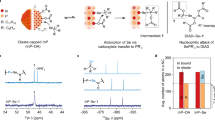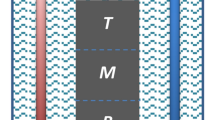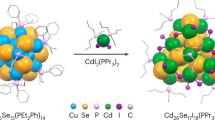Abstract
Doping is a process in which atomic impurities are intentionally added to a host material to modify its properties. It has had a revolutionary impact in altering or introducing electronic1,2, magnetic3,4, luminescent5,6, and catalytic7 properties for several applications, for example in semiconductors. Here we explore and demonstrate the extension of the concept of substitutional atomic doping to nanometre-scale crystal doping, in which one nanocrystal is used to replace another to form doped self-assembled superlattices. Towards this goal, we show that gold nanocrystals act as substitutional dopants in superlattices of cadmium selenide or lead selenide nanocrystals when the size of the gold nanocrystal is very close to that of the host. The gold nanocrystals occupy random positions in the superlattice and their density is readily and widely controllable, analogous to the case of atomic doping, but here through nanocrystal self-assembly. We also show that the electronic properties of the superlattices are highly tunable and strongly affected by the presence and density of the gold nanocrystal dopants. The conductivity of lead selenide films, for example, can be manipulated over at least six orders of magnitude by the addition of gold nanocrystals and is explained by a percolation model. As this process relies on the self-assembly of uniform nanocrystals, it can be generally applied to assemble a wide variety of nanocrystal-doped structures for electronic, optical, magnetic, and catalytic materials.
This is a preview of subscription content, access via your institution
Access options
Subscribe to this journal
Receive 51 print issues and online access
$199.00 per year
only $3.90 per issue
Buy this article
- Purchase on Springer Link
- Instant access to full article PDF
Prices may be subject to local taxes which are calculated during checkout



Similar content being viewed by others
References
Erwin, S. C. et al. Doping semiconductor nanocrystals. Nature 436, 91–94 (2005)
Norris, D. J., Efros, A. L. & Erwin, S. C. Doped nanocrystals. Science 319, 1776–1779 (2008)
Pearton, S. J. et al. Wide band gap ferromagnetic semiconductors and oxides. J. Appl. Phys. 93, 1–13 (2003)
Röder, H., Zang, J. & Bishop, A. R. Lattice effects in the colossal-magnetoresistance manganites. Phys. Rev. Lett. 76, 1356–1359 (1996)
Wang, F. et al. Simultaneous phase and size control of upconversion nanocrystals through lanthanide doping. Nature 463, 1061–1065 (2010)
Ye, X. et al. Morphologically controlled synthesis of colloidal upconversion nanophosphors and their shape-directed self-assembly. Proc. Natl Acad. Sci. USA 107, 22430–22435 (2010)
Asahi, R. et al. Visible-light photocatalysis in nitrogen-doped titanium oxides. Science 293, 269–271 (2001)
Murray, C. B., Norris, D. J. & Bawendi, M. G. Synthesis and characterization of nearly monodisperse CdE (E = S, Se, Te) semiconductor nanocrystallites. J. Am. Chem. Soc. 115, 8706–8715 (1993)
Park, J. et al. One-nanometer-scale size-controlled synthesis of monodisperse magnetic iron oxide nanoparticles. Angew. Chem. Int. Ed. 44, 2872–2877 (2005)
Pileni, M. P. Self organization of inorganic nanocrystals: unexpected chemical and physical properties. J. Colloid Interf. Sci. 388, 1–8 (2012)
Talapin, D. V., Lee, J. S., Kovalenko, M. V. & Shevchenko, E. V. Prospects of colloidal nanocrystals for electronic and optoelectronic applications. Chem. Rev. 110, 389–458 (2010)
Shevchenko, E. V. et al. Structural diversity in binary nanoparticle superlattices. Nature 439, 55–59 (2006)
Urban, J. J. et al. Synergism in binary nanocrystal superlattices leads to enhanced p-type conductivity in self-assembled PbTe/Ag2Te thin films. Nature Mater. 6, 115–121 (2007)
Dong, A. et al. Binary nanocrystal superlattice membranes self-assembled at the liquid–air interface. Nature 466, 474–477 (2010)
Tanemura, M. Statistical distributions of Poisson Voronoi cells in two and three dimensions. Forma 18, 221–247 (2003)
Bodnarchuk, M. I., Kovalenko, M. V., Heiss, W. & Talapin, D. V. Energetic and entropic contributions to self-assembly of binary nanocrystal superlattices: temperature as the structure-directing factor. J. Am. Chem. Soc. 132, 11967–11977 (2010)
Meledina, M. et al. Local environment of Fe dopants in nanoscale Fe: CeO2 − x oxygen storage material. Nanoscale 7, 3196–3204 (2015)
Boneschanscher, M. P. et al. Long-range orientation and atomic attachment of nanocrystals in 2D honeycomb superlattices. Science 344, 1377–1380 (2014)
Fafarman, A. T. et al. Thiocyanate-capped nanocrystal colloids: vibrational reporter of surface chemistry and solution-based route to enhanced coupling in nanocrystal solids. J. Am. Chem. Soc. 133, 15753–15761 (2011)
Dong, A., Jiao, Y. & Milliron, D. J. Electronically coupled nanocrystal superlattice films by in situ ligand exchange at the liquid–air interface. ACS Nano 7, 10978–10984 (2013)
Efros, A. L. & Shklovskii, B. I. Critical behaviour of conductivity and dielectric constant near the metal-non-metal transition threshold. Phys. Status Solid. B 76, 475–485 (1976)
Lorenz, C. D., May, R. & Ziff, R. M. Similarity of percolation thresholds on the HCP and FCC lattices. J. Stat. Phys. 98, 961–970 (2000)
Rintoul, M. D. & Torquato, S. Precise determination of the critical threshold and exponents in a three-dimensional continuum percolation model. J. Phys. Math. Gen. 30, L585 (1997)
Houtepen, A. J., Kockmann, D. & Vanmaekelbergh, D. Reappraisal of variable-range hopping in quantum-dot solids. Nano Lett. 8, 3516–3520 (2008)
Zabet-Khosousi, A. et al. Metal to insulator transition in films of molecularly linked gold nanoparticles. Phys. Rev. Lett. 96, 156403 (2006)
Fafarman, A. T. et al. Chemically tailored dielectric-to-metal transition for the design of metamaterials from nanoimprinted colloidal nanocrystals. Nano Lett. 13, 350–357 (2013)
Bo, X. Z. et al. Carbon nanotubes-semiconductor networks for organic electronics: the pickup stick transistor. Appl. Phys. Lett. 86, 1–3 (2005)
Overgaag, K., Liljeroth, P., Grandidier, B. & Vanmaekelbergh, D. Scanning tunneling spectroscopy of individual PbSe quantum dots and molecular aggregates stabilized in an inert nanocrystal matrix. ACS Nano 2, 600–606 (2008)
Peng, S. et al. A facile synthesis of monodisperse Au nanoparticles and their catalysis of CO oxidation. Nano Research 1, 229–234 (2008)
Yu, W. W., Falkner, J. C., Shih, B. S. & Colvin, V. L. Preparation and characterization of monodisperse PbSe semiconductor nanocrystals in a noncoordinating solvent. Chem. Mater. 16, 3318–3322 (2004)
Acknowledgements
We thank Y. Lai and D. Straus (University of Pennsylvania) for discussions about electrical characterization. This work received primary support from the Office of Naval Research MURI program (award number ONR-N00014-10-1-0942) for the development of the multicomponent assembly techniques, and secondary support from the US Department of Energy Office of Basic Energy Sciences, Division of Materials Science and Engineering (award number DE-SC0002158) for the development of the semiconductor nanocrystal chemistry and the characterization of electrical conductivity. Electron microscopy research was performed while A.C.J.-P. held a National Research Council Research Associateship Award at the National Institute of Standards and Technology. We thank K. Yager (Brookhaven National Laboratory) for help with SAXS experiments. Work performed at the National Synchrotron Light Source I (Brookhaven National Laboratory) was supported by the US Department of Energy, Office of Basic Energy Sciences, under contract number DE-SC0012704. C.R.K. thanks the Stephen J. Angello Professorship for support. C.B.M. is grateful for the support of the Richard Perry University Professorship.
Author information
Authors and Affiliations
Contributions
M.C., B.T.D. and C.B.M. conceived the idea for the study. M.C. prepared the samples and conducted initial characterization. A.C.J.-P. performed microscopy characterization and tomography reconstruction. B.D. and D.D. contributed to sample preparation and Voronoi analysis. V.V.T.D.-N. contributed to Voronoi analysis and Matlab programming. E.W. prepared electrical substrates and contributed to electrical characterization. M.C. and B.T.D. performed electrical characterization. A.A.H. supervised microscopy characterization. C.R.K. supervised electrical characterization. C.B.M. supervised the entire project. M.C. wrote the manuscript with contributions from all the authors.
Corresponding author
Ethics declarations
Competing interests
The authors declare no competing financial interests.
Extended data figures and tables
Extended Data Figure 1 Characterization of starting building blocks.
a, b, Representative TEM images; c, d, ultraviolet–visible spectra; e, f, small-angle X-ray scattering (SAXS) patterns, of Au nanocrystals (a, c, e) and CdSe nanocrystals (b, d, f). For Au, the SAXS data include the fit to particle size and size dispersion (solid black trace), providing an estimated particle diameter of 6.85 ± 0.45 nm (95% confidence, including organic ligand shell).
Extended Data Figure 2 Long-range large-area ordering in doped nanocrystal superlattices.
Low-magnification TEM image of CdSe superlattices doped with Au, showing the large areas (at least 5 µm2) of ordered assemblies formed onto TEM grids. Inset, digital diffraction pattern showing the hexagonal long-range ordering in the superlattices.
Extended Data Figure 3 Voronoi analysis of doped monolayer superlattices.
a–d, Representative TEM images of mixed Au/CdSe ordered monolayers with different densities of Au nanocrystals: a, 66 nanocrystals µm−2; b, 128 nanocrystals µm−2; c, 183 nanocrystals µm−2; d, 317 nanocrystals µm−2. e, Corresponding larger-area Voronoi diagrams. f, Associated particle–particle distance histograms. g, Average number of edges.
Extended Data Figure 4 Segregation of dopants.
Superlattices assembled from oleylamine-capped Au nanocrystals and oleic-acid-capped CdSe nanocrystals. Au nanocrystals tend to segregate and agglomerate at grain boundaries instead of mixing with CdSe nanocrystals. The grain boundary between two assembled regions of CdSe nanocrystals is highlighted by a dashed white line.
Extended Data Figure 5 Segregation of Au nanocrystals owing to size mismatch.
Assembly of 6.5-nm PbSe nanocrystals and 5.5-nm Au nanocrystals (NCs) at the liquid–air interface. Arrows point to grain boundaries or regions on top of the PbSe superlattices (SLs) where Au nanocrystals segregate preferentially.
Extended Data Figure 6 PbSe superlattices doped with Au/Ag nanocrystals.
The images show the assembly of PbSe superlattices doped with different Au/Ag concentrations by volume at the liquid–air interface.
Extended Data Figure 7 Segregation of dopants in multilayers.
TEM images showing preferential segregation of Au nanocrystals to regions of CdSe multilayers rather than monolayers. Grain boundaries are highlighted with dashed white lines.
Extended Data Figure 8 Characterization of ligand-exchanged doped superlattices.
a, b, Representative TEM images of Au/Ag-doped PbSe films following ligand exchange of the long, alkyl ligands with compact thiocyanate ions. Extensive cracks are formed, especially where the grain boundaries were present. c, Selected area electron diffraction pattern of Au/Ag–PbSe assemblies, showing a low degree of preferential orientation of the crystallographic axes. d, e, Au–CdSe films before (d) and after (e) ligand exchange, showing that the order is preserved to a large extent, given the presence of hexagonal close-packed patches in the sample. f, High-resolution STEM of an Au/Ag–PbSe film after ligand exchange. g, h, TSAXS and GISAXS analysis of the films before (g) and after (h) ligand exchange.
Extended Data Figure 9 Substrates for conductivity measurements.
Optical microscopy images of the patterned substrates covered with the doped superlattices for conductivity measurements.
Extended Data Figure 10 Temperature-dependent conductivity models.
a–d, Fitting of different temperature-dependent conductivity models to data obtained for samples of PbSe doped with 16.5% Au/Ag. The best single fit out of several possibilities over the entire temperature range is a modified form of the Efros–Shklovskii variable-range hopping with T−2/3 dependence, shown in b. The observation of this behaviour in sub-percolation doped superlattices is to be expected, because conductivity is constrained by hopping to non-nearest neighbours. The good fit obtained using the general T−1 expression for near-neighbour hopping, shown in a, not surprisingly still describes the system quite well, given that the composition is close to the percolation threshold. However, a reduced activation energy analysis also suggests that the transport behaviour is in best agreement with modified Efros–Shklovskii hopping. The original Efros–Shklovskii variable-range hopping dependence with T−1/2 shown in c was found in the past to describe CdSe solids well; however, the presence of Au nanocrystal dopants clearly changes the behaviour in our system compared with the behaviour of pure quantum dot solids. The Mott variable-range hopping with a dependency of T−1/4, shown in d, clearly does not describe the system, probably because of the increased density of states in the solid owing to the presence of the Au nanocrystal dopants.
Supplementary information
Tomography reconstruction of multilayer doped superlattices
Video showing a YZ slice progression of the reconstruction volume of Au NC-PbSe NC doped superlattices reported in Figure 2 of the main text. Au NCs appear as bright spots in the ordered layers and are then isolated as single yellow spheres in the final reconstruction. (MP4 7850 kb)
Source data
Rights and permissions
About this article
Cite this article
Cargnello, M., Johnston-Peck, A., Diroll, B. et al. Substitutional doping in nanocrystal superlattices. Nature 524, 450–453 (2015). https://doi.org/10.1038/nature14872
Received:
Accepted:
Published:
Issue Date:
DOI: https://doi.org/10.1038/nature14872
This article is cited by
-
Nanocluster superstructures assembled via surface ligand switching at high temperature
Nature Synthesis (2023)
-
Nanocrystal phononics
Nature Materials (2023)
-
Crystallization of binary nanocrystal superlattices and the relevance of short-range attraction
Nature Synthesis (2023)
-
Hydrogels totally from inorganic nanosheets and water with mechanical robustness, self-healing, controlled lubrication and anti-corrosion
Nano Research (2023)
-
Spatially resolved fluorescence of caesium lead halide perovskite supercrystals reveals quasi-atomic behavior of nanocrystals
Nature Communications (2022)
Comments
By submitting a comment you agree to abide by our Terms and Community Guidelines. If you find something abusive or that does not comply with our terms or guidelines please flag it as inappropriate.



